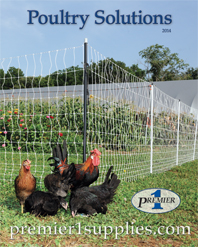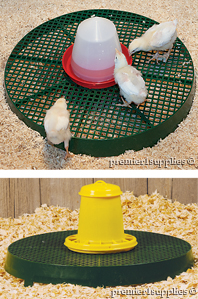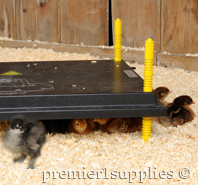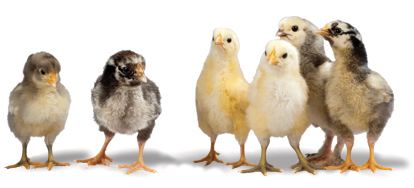NEW! POULTRY
SOLUTIONS CATALOG

New! Poultry Solutions catalog due in your mailbox the 1st week of January.
New Poultry Products
Coming Soon!
| • |
Poultry Door—Reliable automatic door with daylight sensor opens to let birds out at sunrise, closes to secure the coop at dusk. |
Available Now!
| • |
Heating Plate & Chick Drinker—An alternative to heat lamps for chicks. Nipple drinker sits on plate or hangs to provide always-clean water. |
| • |
Plastic Leg Bands—Identify your birds with small, medium or large prenumbered (1 to 25) plastic leg bands. 3 sizes in 5 colors. |
| • |
Aluminum Feed Scoops—Durable scoops with reversed handle are “friendly” to hand and wrist. |
| • |
Poultry Crate—Large, sturdy transport crate, 2 doors. Collapses for shipping. |
| • |
Ceramic Eggs—New sizes for geese and quail. |
| • |
Egg Stamps & Ink—Mark eggs as your own with stamps or customizable names/logos. |
| • |
Vintage Egg Carton—Old-fashioned farm scene on lid of the carton; 3 rows of 4 eggs. |
| • |
Egg Skelter—Keep eggs in style on countertop. |
| • |
EZ CatchNet—Lightweight, strong net, convenient telescoping handle. |
| • |
NoShock Chick Fence—Allows young poultry to forage outside even when they’re too small for regular electrified netting. |
| • |
FiberTuff™ Posts—Support for netting at curves, corners, ends and major directional changes. |
| • |
HotGate® and Handle Kit—Complete net gate ties onto the end of existing electrified poultry net. Handles allow for easy “shock-free” access into any netting enclosure. |
USEFUL ITEMS FOR
RAISING CHICKS
 Chick Stand
Chick Stand
Designed to lift waterers and feeders up and out of litter to provide a cleaner location around high traffic feeding/watering areas.
Classic Waterer
2 lb capacity. Easy-to-use push-fit base. Simple to clean. Cone shaped top discourages birds from perching.
Saturn 3
3 lb capacity. For use in a brooder or with only a few birds.
NEW PRODUCT

Set the Heating Plate low enough so it lightly touches the backs of chicks. Legs are adjustable to accommodate chicks of all ages.
Heating Plate!
An alternative to a heat lamp. The heating plate simulates a hen keeping chicks warm and cozy beneath her feathers. Chicks stay warm from touching the underside of the heating plate. Easy push-button legs adjust to change height of heating plate.
A heating plate is not a heat source like a heat bulb. A heat bulb becomes very hot and radiates the heat downwards. A heating plate is completely different, as only the surface of the bottom side of the heating plate is warm. Chicks must touch the heating plate, especially when they are newly hatched. For that reason the height adjustment is crucial. Available in large or small sizes.
Covers available to prevent chicks from perching on top of the plate.
|
 |
 |

When an assortment of chicks are delivered by mail, it's always fun to guess which breeds the chicks might be.
Almost time for chicks!
Whether you're a fan of fancy breeds, planning for dozens of fresh eggs or just need a few broilers to stock the larder, it's the time of year to start thinking about the birds you'd like to add to your flock.
Barred Rocks, Buff Orpingtons and Speckled Sussex seem to be the go-to's for backyard fowl. But there are quite a few other breeds available that are worth checking out. A few states even have breeds named after them—Iowa (Iowa Blues), New Hampshire (New Hampshire Red), Delaware (Delaware), Ohio (Buckeyes) and of course Rhode Island (Rhode Island Red). All have roots in the U.S., as do the Dominiques, Plymouth Rocks, Wyandottes and Jersey Giants.
Then take a look at some of the breeds you may not have seen before, such as Houdan, Australorp, Shamo or Cochin.
If you're interested in birds from throughout the world, check out these: Chantecler is a hardy Canadian breed, Orpington's are an excellent representation of English fowl, La Fleche are a seldom-seen Continental (European) variety with a distinctive "V" comb, and Andalusians are spirited Mediterranean birds with a lovely blue color.
Enjoy perusing the various poultry catalogs for new chicken breeds. Place your order or make plans to buy chicks locally. Then start planning for their arrival.
See our Poultry Supplies catalog or visit our website for useful products.
See the article and sources below on choosing a chicken breed.
EXTENSION NEWS
Choosing a Chicken Breed: Eggs, Meat or Exhibition
by Doug Akers, Pete Akers and Dr. Mickey A. Latour
Purdue University Cooperative Extension Service, West Lafayette, IN
There are many reasons for raising chickens. People raise chickens for eggs, meat, exhibition, and rare breed preservation, as well as for the enjoyment of raising, caring for, and watching their interesting behavior. Some people raise them to hear a rooster crow to symbolize past days on the farm.
There is a wide array of chicken breeds. Choosing the right type of chicken can be difficult. The purpose of this publication is to help beginners determine which types of chickens are most suited to their needs.
Egg production. White Leghorns (pronounced leggerns) are prolific layers of white eggs. Golden Comets and Red Sex Links are excellent layers of brown eggs. In general, chicken breeds with white ear lobes lay white eggs, whereas chickens with red ear lobes lay brown eggs.
Eggs and meat. Dual purpose breeds include several American and English breeds such as Plymouth Rocks, Sussex, and Wyandottes. These breeds lay reasonably well and are large enough for meat production.
Meat. For meat production only, nothing compares with the fast growth of Cornish Cross (White Cornish x White Plymouth Rock). They reach 4-5 lbs in 6 weeks and 6-10 lbs in 8-12 weeks.
Exhibition. Exhibition poultry shows are popular in Indiana and the Midwest. The American Poultry Association (APA) publishes, The American Standard of Perfection. This illustrated book gives a complete description of all recognized breeds and varieties of domestic poultry. Chickens are judged according to those descriptions of ideal breed type, color, weight, and other characteristics for the particular breed and variety.
Read More »
EXTENSION NEWS
Small Flock Series: Managing a Family Chicken Flock
by Jesse J. Lyons
Department of Animal Sciences, University of Missouri-Columbia
Maintaining a small poultry flock can be rewarding and will provide an opportunity for various family members to participate in animal care. Chickens are best maintained as a flock and are well suited for such management. Other species of poultry are also well suited for family flock management; however, mixed flocks (mixed ages or species) are not recommended because of increased risk of disease.
With proper care and consideration, the small family flock may be maintained on farms or small acreages near urban areas.
Before you start a flock
Make sure that your enjoyment of your flock does not infringe on your neighbors’ enjoyment of their properties. Check to see if zoning regulations or other property restrictions prohibit or restrict raising poultry on your property. Fence in small flocks of birds for their own safety and to keep them home.
It is essential not only that your poultry operation be considered legal, but also that it be considered appropriate for the neighborhood. Consideration of neighbors and discussions with them before bringing livestock into a residential community may avoid future problems. There are also many predatory animals even within municipal boundaries and chickens are usually easy prey. Chickens on roadways are a hazard both for themselves and for motorists. Backyard flocks of chickens are a potential source of disease that can spread to commercial birds. Disease organisms may be carried on shoes and clothing. To contain and protect the flock, extend poultry yard fencing all the way to the ground and make sure the mesh of the fence is small. Chicken wire works well; it can be found at most livestock feed and supply stores. Cover the top of the enclosure, as well, to prevent flying or climbing predators from entering.
Read More »
POULTRY SOURCES
Best places to find poultry?
If you're looking for a hatchery, below are a few links to some folks whose names we've come across over the years. If possible, choose a hatchery that is close to your location. This helps to shorten the distance and time chicks will need to travel. Most of the hatcheries listed are located in the Midwest.
BROODER BASICS
Setting up a brooder…
What is a brooder?
A chick’s first home. It can be as simple as a cardboard box with bedding or a commercially produced appliance designed for hundreds of chicks.
Why do I need a brooder?
Young birds are susceptible to cold drafts and disease. A brooder is a well ventilated, secure structure that keeps chicks close to warmth, food and water.
What do the chicks need?
Constant access to food and water. They grow rapidly and therefore have high nutritional demands.
Do I need bedding?
Yes. Bedding insulates the brooder floor, helps keep the chicks dry and absorbs moisture from their droppings.
For the first day, lay newspaper on the floor. After the chicks learn where the feed is, switch to conventional bedding.
We use pine wood shavings. Others use chopped straw, shredded paper or old newspapers (unshredded). Crushed corncobs, peat moss, vermiculite and coarse sand can also be used.
Be sure to replace the bedding often because the birds will soil it. Clean bedding = clean chicks = healthy, live birds. Dirty bedding = the opposite.

Like to know how to set up a brooder for chicks and other newborn poultry? Watch the video below for a helpful how-to.
|
What about heat lamps?
Heat lamps should be placed about 18" above the bedding. If the chicks are evenly distributed over the floor the temperature is comfortable for them.
If your chicks huddle under the light, lower the lamp to raise the temperature in the brooder.
If the chicks are not under the lamp, raise the lamp to reduce the amount of direct heat on them. For a large number of chicks, use 2 or more heat lamps.
What color bulb should I use?
Both colors provide heat and light. Clear bulbs provide more illumination. Red bulbs provide slightly more heat.
Many feel the red bulbs reduce the amount of pecking (on other chicks).
|
|